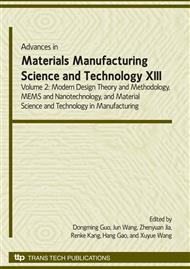p.281
p.287
p.293
p.299
p.305
p.311
p.317
p.323
p.329
Study on Drive Characteristic of Multi–Rope Friction Winder Using Functional Virtual Prototyping
Abstract:
The main objective of this study was to model and simulate a reduced three-dimensional (3D) model for researching the hoisting system of a Multi – rope Friction Winder. By introducing the relative nodal method, the simplified dynamic equations have been derived via the virtual work principle and validated on a virtual prototype with the RecurDyn software package. Kinematics and dynamics characteristic date are obtained by computer-aided dynamic simulation of virtual Multi – rope friction winder. The result is in accord with theoretical analysis. The research work will provide a powerful tool and useful method for the design of economic and credible elevator system. The approach can be generalized to analysis other flexible drive fields.
Info:
Periodical:
Pages:
305-310
Citation:
Online since:
August 2009
Authors:
Price:
Сopyright:
© 2009 Trans Tech Publications Ltd. All Rights Reserved
Share:
Citation:


